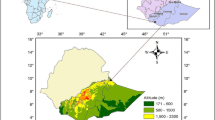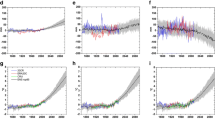Abstract
Presented is the review of the modern knowledge of the Arctic Oscillation (AO). Demonstrated is the relation of air temperature and precipitation in Northern Eurasia to this dominant type of wintertime atmospheric variability at northern extratropical latitudes. It is demonstrated that AO is a result of the coupling between the troposphere and stratosphere. The attention is paid to the long-range forecasting of AO index and to the factors complicating the forecasting. Given are the new results of the authors’ research. Used is the wintertime AO index computed by the authors from the 20th Century Reanalysis dataset. The high- and low-frequency components of AO index variability and the periods of statistically significant trends are analyzed using the 112-year series (1901-2012). Demonstrated is the key impact of wintertime AO phase on the anomalies of air temperature and precipitation in Northern Eurasia at the time scale of years and decades. This impact is manifested in the northern part of Northern Eurasia in the prevalence of warmer and wetter winters at the positive AO phase and of colder and drier winters at the negative AO phase. The precipitation anomalies of opposite sign prevail in the southern part of Northern Eurasia. It is demonstrated that the winter AO phase affects the terms of the springtime air temperature transition to positive values.
Similar content being viewed by others
References
G. V. Alekseev, L. V. Bulatov, V. F. Zakharov, and V. V. Ivanov, “Thermal Expansion of Atlantic Water in the Arctic Basin,” Meteorol. Gidrol., No. 7 (1998) [Russ. Meteorol. Hydrol., No. 7 (1998)].
G. V. Alekseev, V. F. Zakharov, A. N. Smirnov, and N. P. Smirnov, “Long-term Variations of Ice Conditions and Atmospheric Circulation in the Atlantic Arctic and North Atlantic,” Meteorol. Gidrol., No. 9 (1998) [Russ. Meteorol. Hydrol., No. 9 (1998)].
R. M. Vil’fand, V. P. Sadokov, and V. A. Tishchenko, “Relationship between the Snow Cover Boundary and Intensity of Cyclonic Activity in the Northern Hemisphere,” Meteorol. Gidrol., No. 9 (2002) [Russ. Meteorol. Hydrol., No. 9 (2002)].
E. M. Volodin and V. Ya. Galin, “Investigation of the First Mode of Low-frequency Variability of the Winter Atmospheric Circutation in Midlatitudes of the Northern Hemisphere,” Meteorol. Gidrol., No. 9 (1998) [Russ. Meteorol. Hydrol., No. 9 (1998)].
V. M. Kattsov, V. P. Meleshko, G. V. Alekseev, et al., “Effect of Sea Ice Compaction on High Latitude Atmo-spheric Variability,” Meteorol. Gidrol., No. 4 (1997) [Russ. Meteorol. Hydrol., No. 4 (1997)].
A. V. Kislov, Climatology (ITs Akademiya, Moscow, 2011) [in Russian].
L. M. Kitaev, “Spatial and Temporal Variations of Snow Depth in the Northern Hemisphere,” Meteorol. Gidrol., No. 5 (2002) [Russ. Meteorol. Hydrol., No. 5 (2002)].
The Climatic Regime in the Arctic at the Turn of the 20th and 21st Cen turies, Ed. by B. A. Krutskikh (Gidro-meteoizdat, St. Petersburg, 1997) [in Russian].
V. N. Kryzhov, “Connection between Monthly Mean, Seasonal, and Annual Air Temperatures in Northern Russia and Winter Zonal Circulation Indices,” Meteorol. Gidrol., No. 2 (2003) [Russ. Meteorol. Hydrol., No. 2 (2003)].
V. N. Kryzhov, “Ret ationship between Annual Mean Air Temperature in Northwestern Eurasia and the Arctic Oscillation,” Meteorol. Gidrol., No. 1 (2004) [Russ. Meteorol. Hydrol., No. 1 (2004)].
V. N. Kryzhov, “Causes of November Cooling of the 1980s-1990s in European Russia,” Meteorol. Gidrol., No. 1 (2008) [Russ. Meteorol. Hydrol., No. 1, 33 (2008)].
M. A. Tolstykh, D. B. Kiktev, R. B. Zaripov, et al., “Simulation of the Seasonal Atmospheric Circulation with the New Version of the Semi-Lagrangian Atmospheric Model,” Izv. Akad. Nauk, Fiz. Atmos. Okeana, No. 2, 46 (2010) [Izv., Atmos. Oceanic Phys., No. 2, 46 (2010)].
S. P. Khromov, Introduction into Synoptic Analysis (Gidrometeoizdat, Moscow, 1937) [in Russian].
J. B. Ahn and H. J. Kim, “Improvement of 1-month Lead Predictability of the Wintertime AO Using a Realis-tically Varying Solar Constant for a CGCM,” Meteorol. Appl., 21 (2014).
M. H. Ambaum and B. J. Hoskins, “The NAO Troposphere-stratosphere Connection,” J. Climate, 15 (2002).
M. P. Baldwin and T. J. Dunkerton, “Propagation of the Arctic Oscillation from the Stratosphere to the Tropo-sphere,” J. Geophys. Res., 104 (1999).
M. P. Baldwin and T. J. Dunkerton, “Stratospheric Harbingers of Anomalous Weather Regimes,” Science, 294 (2001).
M. P. Baldwin, D. W. J. Thompson, E. F. Shuckburgh, et al., “Weather from the Stratosphere?”, Science, 301 (2003).
C. Bretherton, M. Widmann, V. Dymnikov, et al., “The Effective Number of Spatial Degrees of Freedom of a Time-varying Field,” J. Climate, 12 (1999).
J. G. Charney and P. G. Drazin, “Propagation of Planetary-scale Disturbances from the Lower into the Upper Atmosphere,” J. Geophys. Res., 66 (1961).
J. Cohen, M. Barlow, P. J. Kushner, and K. Saito, “Stratosphere-troposphere Coupling and Links with Eurasian Land Surface Variability,” J. Climate, 20 (2007).
J. Cohen, J. Foster, M. Barlow, et al., “Winter 2009-2010: A Case Study of an Extreme Arctic Oscillation Event,” Geophys. Res. Lett., 37 (2010).
G. P. Compo, J. S. Whitaker, P. D. Sardeshmukh, et al., “The Twentieth Century Reanalysis Project,” Quart. J. Roy. Meteorol. Soc., 137 (2011).
G. P. Compo, J. S. Whitaker, and P. D. Sardeshmukh, “Feasibility of a 100 Year Reanalysis Using Only Surface Pressure Data,” Bull. Amer. Meteorol. Soc., 87 (2006).
C. J. Fletcher and P. J. Kushner, “The Role of Linear Interference in the Annular Mode Response to Tropical SST Forcing,” J. Climate, 24 (2011).
C. I. Garfinkel, D. L. Hartmann, and F. Sassi, “Tropospheric Precursors of Anomatous Northern Hemisphere Stratospheric Polar Vortices,” J. Climate, 23 (2010).
P. Y. Groisman, T. E. Karl, R. W. Knight, and G. L. Stenchikov, “Changes of Snow Cover, Temperature, and Radiative Heat Balance over the Northern Hemisphere,” J. Climate, 7 (1994).
D. L. Hartmann, J. M. Wallace, V. Limpasuvan, et al., “Can Ozone Depletion and Global Warming Interact to Produce Rapid Climate Change?”, Proc. Nat. Acad. Sci. USA, 97 (2000).
P. H. Haynes, C. J. Marks, M. E. McIntyre, et al., “On the “Downward Control” of Extratropical Diabatic Circulations by Eddy Induced Mean Zonal Forces,” J. Atmos. Sci., 48 (1991).
IPCCFifth Assessment Report. Climate Change 2013: The Physical Science Basis Working Group I Contribution to the Fifth Assessment Report of the Intergovernmental Panel on Climate Change (Cambridge Univ. Press, Cambridge, United Kingdom and New York, USA, 2013).
V. N. Kryjov, “October Circulation Precursors of the Wintertime Arctic Oscillation,” Int. J. Climat., 35 (2015).
V. N. Kryjov, “Searching for Circulation Patterns Affecting Northern Europe Annual Temperature,” Atmos. Sci. Lett., No. 1, 5 (2004).
V. N. Kryjov, “The Influence of the Winter Arctic Oscillation on the Northern Russia Spring Temperature,” Int. J. Climate, 22 (2002).
V. N. Kryjov and C.-K. Park, “Sotar Modutation of the El Nino/Southern Oscillation Impact on the Northern Hemisphere Annular Mode,” Geophys. Res. Lett., 34 (2007).
Y. Kuroda and K. Kodera, “Role of Planetary Waves in the Stratosphere-troposphere Coupled Variability in the Northern Hemisphere Winter,” Geophys. Res. Lett., 26 (1999).
J. E. Kutzbach, “Large-scale Features of Monthly Mean Northern Hemisphere Anomaly Maps of Sea-level Pressure,” Mon. Wea. Rev., 98 (1970).
V. Limpasuvan, D. L. Hartmann, D. W. J. Thompson, et al., “Stratosphere-troposphere Evolution during Potar Vortex Intensification,” J. Geophys. Res., 110 (2005).
V. Limpasuvan, D. W. J. Thompson, and D. L. Hartmann, “The Life Cycle of Northern Hemisphere Sudden Stratospheric Warmings,” J. Climate, 17 (2004).
E. N. Lorenz, “Seasonal and Irregular Variations of the Northern Hemisphere Sea-level Pressure Profile,” J. Mete-orol., 8 (1951).
T. J. Mosedale, D. B. Stephenson, M. Collins, and T. C. Mills, “Granger Causality of Coupled Climate Processes: Ocean Feedback on the North Atl antic Oscillation,” J. Climate, 19 (2006).
L. L. Pan, “Observed Positive Feedback between the NAO and the North Atlantic SSTA Tripole,” Geophys. Res. Lett., 32 (2005).
I. G. Rigor, J. M. Wallace, and R. L. Colony, “Response of Sea Ice to the Arctic Oscillation,” J. Climate, 15 (2002).
A. A. Scaife, D. Copsey, C. Gordon, et al., “Improved Attantic Blocking in a Climate Model,” Geophys. Res. Lett., 38 (2011).
A. A. Scaife, A. Arribas, E. Blockley, et al., “Skillful Long-range Prediction of European and North American Winters,” Geophys. Res. Lett., 41 (2014).
M. C. Serreze, Northern Hemisphere Cyclone Locations and Characteristics from NCEP/NCAR Reanalysis Data. 1958-2008 (National Snow and Ice Data Center, Boulder, CO, 2009).
D. T. Shindell, G. A. Schmidt, R. L. Miller, and D. Rind, “Northern Hemisphere Winter Climate Response to Greenhouse Gas, Ozone, Solar, and Volcanic Forcing,” J. Geophys. Res., 106 (2001).
J. Sun and J. B. Ahn, “Dynamical Seasonal Predictability of the Arctic Oscillation Using a CGCM,” Int. J. Climat., Wiley Online Library (2014).
D. W. J. Thompson and J. M. Wallace, “The Arctic Oscillation Signature in Wintertime Geopotential Height and Temperature Fields,” Geophys. Res. Lett., 25 (1998).
D. W. J. Thompson and J. M. Wallace, “Annular Modes in the Extratropical Circulation, Part I: Month to Month Variability,” J. Climate, 13 (2000).
D. W. J. Thompson, J. M. Wallace, and G. C. Hegerl, “Annular Modes in the Extratropical Circulation, Part II: Trends,” J. Climate, 13 (2000).
K. E. Trenberth and D. A. Paolino, “Characteristic Patterns of Variability of Sea Level Pressure in the Northern Hemisphere,” Mon. Wea. Rev., 109 (1981).
E. M. Volodin and V. Ya. Galin, “The Nature of the Northern Hemisphere Winter Troposphere Circulation Re-sponse to Observed Ozone Depletion in Low Stratosphere,” Quart. J. Roy. Meteorol. Soc., 124 (1998).
J. M. Wallace, “North Atlantic Oscillation/Annular Mode: Two Paradigms—One Phenomenon,” Quart. J. Roy. Meteorol. Soc., 126 (2000).
J. M. Wallace and D. S. Gutzler, “Teleconnections in the Geopotential Height Field during the Northern Hemi-sphere Winter,” Mon. Wea. Rev., 109 (1981).
L. Wang and W. Chen, “Downward Arctic Oscillation Signal Associated with Moderate Weak Stratospheric Polar Vortex and the Cold December,” Geophys. Res. Lett., 37 (2010).
J. S. Whitaker, G. P. Compo, X. We, and T. M. Hamill, “Reanalysis without Radiosondes Using Ensemble Data Assimilation,” Mon. Wea. Rev., 132 (2004).
D. S. Wilks, “Resampling Hypothesis Tests for Autocorrelated Fields,” J. Climate, 10 (1997).
Author information
Authors and Affiliations
Corresponding author
Additional information
Original Russian Text © V.N. Kryzhov, O.V. Gorelits, 2015, published in Meteorologiya i Gidrologiya, 2015, No. 11, pp. 5–19.
About this article
Cite this article
Kryzhov, V.N., Gorelits, O.V. The Arctic Oscillation and its impact on temperature and precipitation in Northern Eurasia in the 20th Century. Russ. Meteorol. Hydrol. 40, 711–721 (2015). https://doi.org/10.3103/S1068373915110011
Received:
Published:
Issue Date:
DOI: https://doi.org/10.3103/S1068373915110011




